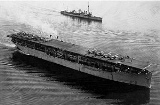
List of aircraft carrier classes of the United States Navy
Encyclopedia
On November 14, 1910, pilot Eugene Burton Ely
took off in a Curtiss
plane from the bow of and later landed a Curtiss Model D
on on 18 January 1911. In fiscal year (FY) 1920, Congress approved a conversion of collier into a ship designed for launching and recovering of airplanes at sea—the first aircraft carrier of the United States Navy. More aircraft carriers were approved and built, including the , the first class of aircraft carriers in the United States Navy designed and built as aircraft carriers from the keel.
The United States
declared war on Japan
following the attack of 7 December 1941 on Pearl Harbor
. The two nations revolutionized naval warfare in the course of the next four years; several of the most important sea battles were fought without either fleet coming within sight of the other. Most of the fleet carriers were built according to prewar designs, but the demand for air protection was so intense that two new classes were developed: light carriers (designated CVL), built on modified cruiser hulls, and escort carriers (CVE), whose main function was to protect Atlantic convoy
s from German U-boat
s.
During the postwar period, carrier technology made many advances. The angled flight deck was adopted in 1955. The first "supercarrier
" was commissioned in 1955 (although an earlier plan had been canceled by the Secretary of Defense), and the first nuclear-powered carrier in 1961, all during the Cold War. Also, a record for crossing the Pacific Ocean
was set by a U.S. Navy carrier during the Korean War
. Carriers recovered spacecraft after splashdown
, including the Mercury-Redstone 3
and Apollo 11
missions.
A new class, the , is planned for 2015. In 2007, the last conventionally powered (non-nuclear) carrier was decommissioned.
, took off in a 50 horsepower
Curtiss
plane from a wooden platform built over the bow of the cruiser ; later, on January 18, 1911, Ely landed a Curtiss Model D
on a platform aboard . The Naval Appropriations Act for Fiscal Year 1920 provided funds for the conversion of into a ship designed for the launching and recovery of airplanes at sea—the United States Navy
's first aircraft carrier
. Renamed , she was commissioned in 1922. Commander
Kenneth Whiting was placed in command. In 1924, Langley reported for duty with the Battle Fleet
, ending two years as an experimental ship.
In 1922, Congress also authorized the conversion of the unfinished battlecruiser
s and the as permitted under the terms of the Washington Naval Treaty
, signed in February 1922. The keel of , the first ship designed and constructed as an aircraft carrier, was laid down in 1931, and the ship was commissioned in 1934.
Following Ranger and before the entry of the United States into World War II, four more carriers were commissioned. was essentially an improved version of Ranger. The others were the three ships of the class.
struck Pearl Harbor
on 7 December 1941, but none of the Pacific Fleet's aircraft carriers were in the harbor. Because a large fraction of the Navy's battleship fleet was put out of commission by the attack, the undamaged aircraft carriers were forced to become the load-bearers of the early part of the war. The first aircraft carrier offensive of the U.S. Navy came on 1 February 1942, when the carriers Enterprise and Yorktown, attacked the Japanese bases in the Marshall
and Gilbert Islands
. The Battle of the Coral Sea
became the first sea battle in history in which neither opposing fleet saw the other. The Battle of Midway
started as a Japanese offensive on Midway Atoll
met by an outnumbered U.S. carrier force, and resulted in a U.S. victory. The Battle of Midway was the turning point in the Pacific War
.
In 1943, new designations for carriers were established, limiting the CV designation to the , the , and the Essex class
. The new designations were CVB (Aircraft carrier, large) for the 45000 long tons (45,722.3 t) carriers being built, and CVL (Aircraft carriers, small
) for the 10000 long tons (10,160.5 t) class built on light cruiser
hulls. The same directive reclassified escort carriers as combatant ships, and changed their symbol from ACV to CVE.
On September 2, 1945, Japan signed the surrender agreement aboard the , ending World War II.
side-wheel paddle steamer
s and converted them into freshwater aircraft carrier training ships. Both vessels were designated with the hull classification symbol IX and lacked hangar decks
, elevators or armament
s. The role of these ships was for the training of pilots for carrier take-offs and landings. Together the Sable and Wolverine trained 17,820 pilots in 116,000 carrier landings with 51,000 landings on Sable alone.
. The first of the 45000 ton carriers, the was commissioned eight days after the end of World War II, on September 10. A larger ship was planned, and in 1948, President Harry Truman approved the construction of a "supercarrier
", a 65000 ton aircraft carrier to be named ; however, the project was canceled in April 1949 by the Secretary of Defense. The Navy's first supercarriers came later, in 1955, with the Forrestal class
. 1953 saw the first test of an angled-deck carrier, the .
The "N" suffix was added to the designation system to represent nuclear power
ed carriers in 1956. The first carrier to receive this suffix was the , commissioned in 1961. The last carrier to be conventionally powered
, the , was commissioned in 1968, and was decommissioned in 2007.
The Korean War
began June 25, 1950, and the need for planes and troops was urgent. Returning from Korea, the made a record trip across the Pacific
—7 days, 10 hours, and 36 minutes. In 1952, all carriers with designations "CV" or "CVB" were reclassified as attack carriers and given the sign "CVA".
As the Mercury-Redstone 3
mission ended, the recovered Commander
Alan B. Shepard, the first American in space, on May 5, 1961. Another aircraft carrier, the , recovered the Apollo 11
astronauts after their splashdown
. Apollo 11 was the first manned landing on the moon, and was composed of astronauts Neil Armstrong
, Buzz Aldrin
, and Michael Collins
.
In 1975, the first Nimitz class
aircraft carrier was commissioned; the Nimitz class are the largest warships in the world; and is the only aircraft carrier class in commission with the U.S. Navy, except for the . Construction and commissioning of the Nimitz class continued after the Cold War.
Also, in 1975, the U.S. Navy simplified the carrier designations—CV, CVA, CVAN, CVB, CVL—into CV for conventionally powered carriers and CVN for nuclear-powered carriers.
ended in 1991, the U.S. Navy
had conventionally powered
carriers from the classes Midway
, Forrestal
, and Kitty Hawk
active, along with the ; and the nuclear
carriers Nimitz
class and the ; however, all of the conventional carriers have been decommissioned. Construction of the Nimitz class continued after the Cold War, and the last Nimitz class carrier was commissioned in 2009.
The next class of supercarriers—the Gerald R. Ford class—is planned to launch the first ship in 2015. The new carriers will be stealthier, and feature A1B reactor
s, electromagnetic catapults
, advanced arresting gear, reduced crew requirements, and a hull design based upon that of the Nimitz class. Ten carriers are planned for the Gerald R. Ford class.
, the U.S. Navy
built escort carriers in large numbers for patrol work, and scouting and escorting convoy
s. Escort carriers were smaller than aircraft carrier
s; escort carrier crews referred to the ships as "Jeep carriers", the press called them "baby flat tops". The escort carriers had lighter armor than aircraft carriers, were slower, had less defensive armament, and fewer aircraft. This smaller variant of carriers was designated "CVE"; a common joke amongst crews was "CVE" meant "Combustible, Vulnerable and Expendable".
Early in the war, German
submarine
s and aircraft were interfering with shipping. The worst losses occurred far at sea—out of the reach of land-based air forces—leading the Royal Navy
to experiment with catapult-launching fighter aircraft
from merchant ships, a somewhat successful approach. However, the number of planes was still limited, so the United Kingdom
appealed to the United States
for help.
Before World War II started, the U.S. Navy had contemplated converting merchant ships to small aircraft carriers for this purpose, so the quick solution was to build escort carriers on merchant ship hulls. The first escort carrier, the , was converted from a freighter. A shortage of merchant ship hulls caused four escort carriers—, , , and —to be built on oil tanker
hulls. In total, 78 escort carriers were built and launched from June 1941 to April 1945.
Eugene Burton Ely
Eugene Burton Ely was an aviation pioneer, credited with the first shipboard aircraft take off and landing.-Background:...
took off in a Curtiss
Curtiss Aeroplane and Motor Company
Curtiss Aeroplane and Motor Company was an American aircraft manufacturer that went public in 1916 with Glenn Hammond Curtiss as president. Throughout the 1920s and 1930s, the company was the largest aircraft manufacturer in the United States...
plane from the bow of and later landed a Curtiss Model D
Curtiss Model D
|-See also:-External links:...
on on 18 January 1911. In fiscal year (FY) 1920, Congress approved a conversion of collier into a ship designed for launching and recovering of airplanes at sea—the first aircraft carrier of the United States Navy. More aircraft carriers were approved and built, including the , the first class of aircraft carriers in the United States Navy designed and built as aircraft carriers from the keel.
The United States
United States
The United States of America is a federal constitutional republic comprising fifty states and a federal district...
declared war on Japan
Empire of Japan
The Empire of Japan is the name of the state of Japan that existed from the Meiji Restoration on 3 January 1868 to the enactment of the post-World War II Constitution of...
following the attack of 7 December 1941 on Pearl Harbor
Pearl Harbor
Pearl Harbor, known to Hawaiians as Puuloa, is a lagoon harbor on the island of Oahu, Hawaii, west of Honolulu. Much of the harbor and surrounding lands is a United States Navy deep-water naval base. It is also the headquarters of the U.S. Pacific Fleet...
. The two nations revolutionized naval warfare in the course of the next four years; several of the most important sea battles were fought without either fleet coming within sight of the other. Most of the fleet carriers were built according to prewar designs, but the demand for air protection was so intense that two new classes were developed: light carriers (designated CVL), built on modified cruiser hulls, and escort carriers (CVE), whose main function was to protect Atlantic convoy
Convoy
A convoy is a group of vehicles, typically motor vehicles or ships, traveling together for mutual support and protection. Often, a convoy is organized with armed defensive support, though it may also be used in a non-military sense, for example when driving through remote areas.-Age of Sail:Naval...
s from German U-boat
U-boat
U-boat is the anglicized version of the German word U-Boot , itself an abbreviation of Unterseeboot , and refers to military submarines operated by Germany, particularly in World War I and World War II...
s.
During the postwar period, carrier technology made many advances. The angled flight deck was adopted in 1955. The first "supercarrier
Supercarrier
Supercarrier is an unofficial descriptive term for the largest type of aircraft carrier, usually displacing over 70,000 long tons.Supercarrier is an unofficial descriptive term for the largest type of aircraft carrier, usually displacing over 70,000 long tons.Supercarrier is an unofficial...
" was commissioned in 1955 (although an earlier plan had been canceled by the Secretary of Defense), and the first nuclear-powered carrier in 1961, all during the Cold War. Also, a record for crossing the Pacific Ocean
Pacific Ocean
The Pacific Ocean is the largest of the Earth's oceanic divisions. It extends from the Arctic in the north to the Southern Ocean in the south, bounded by Asia and Australia in the west, and the Americas in the east.At 165.2 million square kilometres in area, this largest division of the World...
was set by a U.S. Navy carrier during the Korean War
Korean War
The Korean War was a conventional war between South Korea, supported by the United Nations, and North Korea, supported by the People's Republic of China , with military material aid from the Soviet Union...
. Carriers recovered spacecraft after splashdown
Splashdown (spacecraft landing)
Splashdown is the method of landing a spacecraft by parachute in a body of water. It was used by American manned spacecraft prior to the Space Shuttle program. It is also possible for the Russian Soyuz spacecraft and Chinese Shenzhou spacecraft to land in water, though this is only a contingency...
, including the Mercury-Redstone 3
Mercury-Redstone 3
Mercury-Redstone 3 was the first manned space mission of the United States. Astronaut Alan Shepard piloted a 15-minute Project Mercury suborbital flight in the Freedom 7 spacecraft on May 5, 1961 to become the first American in space, three weeks after the Soviet cosmonaut Yuri Gagarin had carried...
and Apollo 11
Apollo 11
In early 1969, Bill Anders accepted a job with the National Space Council effective in August 1969 and announced his retirement as an astronaut. At that point Ken Mattingly was moved from the support crew into parallel training with Anders as backup Command Module Pilot in case Apollo 11 was...
missions.
A new class, the , is planned for 2015. In 2007, the last conventionally powered (non-nuclear) carrier was decommissioned.
Pre–World War II
On November 14, 1910, a 24 year old civilian pilot, Eugene Burton ElyEugene Burton Ely
Eugene Burton Ely was an aviation pioneer, credited with the first shipboard aircraft take off and landing.-Background:...
, took off in a 50 horsepower
Horsepower
Horsepower is the name of several units of measurement of power. The most common definitions equal between 735.5 and 750 watts.Horsepower was originally defined to compare the output of steam engines with the power of draft horses in continuous operation. The unit was widely adopted to measure the...
Curtiss
Curtiss Aeroplane and Motor Company
Curtiss Aeroplane and Motor Company was an American aircraft manufacturer that went public in 1916 with Glenn Hammond Curtiss as president. Throughout the 1920s and 1930s, the company was the largest aircraft manufacturer in the United States...
plane from a wooden platform built over the bow of the cruiser ; later, on January 18, 1911, Ely landed a Curtiss Model D
Curtiss Model D
|-See also:-External links:...
on a platform aboard . The Naval Appropriations Act for Fiscal Year 1920 provided funds for the conversion of into a ship designed for the launching and recovery of airplanes at sea—the United States Navy
United States Navy
The United States Navy is the naval warfare service branch of the United States Armed Forces and one of the seven uniformed services of the United States. The U.S. Navy is the largest in the world; its battle fleet tonnage is greater than that of the next 13 largest navies combined. The U.S...
's first aircraft carrier
Aircraft carrier
An aircraft carrier is a warship designed with a primary mission of deploying and recovering aircraft, acting as a seagoing airbase. Aircraft carriers thus allow a naval force to project air power worldwide without having to depend on local bases for staging aircraft operations...
. Renamed , she was commissioned in 1922. Commander
Commander (United States)
In the United States, commander is a military rank that is also sometimes used as a military title, depending on the branch of service. It is also used as a rank or title in some organizations outside of the military, particularly in police and law enforcement.-Naval rank:In the United States...
Kenneth Whiting was placed in command. In 1924, Langley reported for duty with the Battle Fleet
Battle Fleet
The United States Battle Fleet or Battle Force was part of the organization of the United States Navy from 1922 to 1941.The General Order of 6 December 1922 organized the United States Fleet, with the Battle Fleet as the Pacific presence. This fleet comprised the main body of ships in the Navy,...
, ending two years as an experimental ship.
In 1922, Congress also authorized the conversion of the unfinished battlecruiser
Battlecruiser
Battlecruisers were large capital ships built in the first half of the 20th century. They were developed in the first decade of the century as the successor to the armoured cruiser, but their evolution was more closely linked to that of the dreadnought battleship...
s and the as permitted under the terms of the Washington Naval Treaty
Washington Naval Treaty
The Washington Naval Treaty, also known as the Five-Power Treaty, was an attempt to cap and limit, and "prevent 'further' costly escalation" of the naval arms race that had begun after World War I between various International powers, each of which had significant naval fleets. The treaty was...
, signed in February 1922. The keel of , the first ship designed and constructed as an aircraft carrier, was laid down in 1931, and the ship was commissioned in 1934.
Following Ranger and before the entry of the United States into World War II, four more carriers were commissioned. was essentially an improved version of Ranger. The others were the three ships of the class.
| Designation | Class | Ships | Active | Description | Lead Ship |
|---|---|---|---|---|---|
| CV-1 | 1922 – 1936 | Converted from . Experimental ship, served 1925-36 as an aircraft carrier before being converted to a seaplane tender Seaplane tender A seaplane tender is a ship that provides facilities for operating seaplanes. These ships were the first aircraft carriers and appeared just before the First World War.-History:... and given the new hull symbol AV-3. |
.jpg) |
||
| CV-2 | Lexington Lexington class aircraft carrier The Lexington class aircraft carriers were the first operational aircraft carriers in the United States Navy. There were two ships in the class: and .... |
1927 – 1946 | The ships were laid down and partly built as part of a six-member Lexington class battlecruiser The Lexington-class battlecruisers were the only class of battlecruiser to ever be ordered by the United States Navy.The Lexington class were the only class of U.S. Navy ships to be officially referred to as battlecruisers. The World War II-era , officially classified as "large cruisers", but some... battlecruiser Battlecruiser Battlecruisers were large capital ships built in the first half of the 20th century. They were developed in the first decade of the century as the successor to the armoured cruiser, but their evolution was more closely linked to that of the dreadnought battleship... class before being converted to carriers while under construction. |
 |
|
| CV-4 | 1934 – 1946 | First purpose-built US Navy aircraft carrier. |  |
||
| CV-5 | Yorktown Yorktown class aircraft carrier The Yorktown class was a class of three aircraft carriers built by the U.S. and completed shortly before World War II. They bore the brunt of early action in that war, and the sole survivor of the class was to become the most decorated ship in the history of the U.S... |
1937 – 1947 | Hornet was built after Wasp. By the end of September 1942, both Yorktown and Hornet were on the bottom of the Pacific; , the orphaned sister of the class, became a symbol of the Pacific War Pacific War The Pacific War, also sometimes called the Asia-Pacific War refers broadly to the parts of World War II that took place in the Pacific Ocean, its islands, and in East Asia, then called the Far East... . |
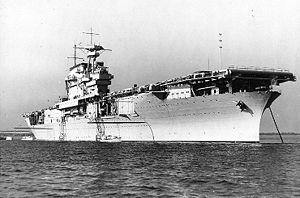 |
|
| CV-7 | 1940 – 1942 | Modified Yorktown class, built on 3,000 less tons to use up allotted tonnage under the Washington Naval Treaty Washington Naval Treaty The Washington Naval Treaty, also known as the Five-Power Treaty, was an attempt to cap and limit, and "prevent 'further' costly escalation" of the naval arms race that had begun after World War I between various International powers, each of which had significant naval fleets. The treaty was... . |
.jpg) |
World War II
The Imperial Japanese NavyImperial Japanese Navy
The Imperial Japanese Navy was the navy of the Empire of Japan from 1869 until 1947, when it was dissolved following Japan's constitutional renunciation of the use of force as a means of settling international disputes...
struck Pearl Harbor
Attack on Pearl Harbor
The attack on Pearl Harbor was a surprise military strike conducted by the Imperial Japanese Navy against the United States naval base at Pearl Harbor, Hawaii, on the morning of December 7, 1941...
on 7 December 1941, but none of the Pacific Fleet's aircraft carriers were in the harbor. Because a large fraction of the Navy's battleship fleet was put out of commission by the attack, the undamaged aircraft carriers were forced to become the load-bearers of the early part of the war. The first aircraft carrier offensive of the U.S. Navy came on 1 February 1942, when the carriers Enterprise and Yorktown, attacked the Japanese bases in the Marshall
Marshall Islands
The Republic of the Marshall Islands , , is a Micronesian nation of atolls and islands in the middle of the Pacific Ocean, just west of the International Date Line and just north of the Equator. As of July 2011 the population was 67,182...
and Gilbert Islands
Gilbert Islands
The Gilbert Islands are a chain of sixteen atolls and coral islands in the Pacific Ocean. They are the main part of Republic of Kiribati and include Tarawa, the site of the country's capital and residence of almost half of the population.-Geography:The atolls and islands of the Gilbert Islands...
. The Battle of the Coral Sea
Battle of the Coral Sea
The Battle of the Coral Sea, fought from 4–8 May 1942, was a major naval battle in the Pacific Theater of World War II between the Imperial Japanese Navy and Allied naval and air forces from the United States and Australia. The battle was the first fleet action in which aircraft carriers engaged...
became the first sea battle in history in which neither opposing fleet saw the other. The Battle of Midway
Battle of Midway
The Battle of Midway is widely regarded as the most important naval battle of the Pacific Campaign of World War II. Between 4 and 7 June 1942, approximately one month after the Battle of the Coral Sea and six months after Japan's attack on Pearl Harbor, the United States Navy decisively defeated...
started as a Japanese offensive on Midway Atoll
Midway Atoll
Midway Atoll is a atoll in the North Pacific Ocean, near the northwestern end of the Hawaiian archipelago, about one-third of the way between Honolulu, Hawaii, and Tokyo, Japan. Unique among the Hawaiian islands, Midway observes UTC-11 , eleven hours behind Coordinated Universal Time and one hour...
met by an outnumbered U.S. carrier force, and resulted in a U.S. victory. The Battle of Midway was the turning point in the Pacific War
Pacific War
The Pacific War, also sometimes called the Asia-Pacific War refers broadly to the parts of World War II that took place in the Pacific Ocean, its islands, and in East Asia, then called the Far East...
.
In 1943, new designations for carriers were established, limiting the CV designation to the , the , and the Essex class
Essex class aircraft carrier
The Essex class was a class of aircraft carriers of the United States Navy, which constituted the 20th century's most numerous class of capital ships with 24 vessels built in both "short-hull" and "long-hull" versions. Thirty-two were originally ordered; however as World War II wound down, six were...
. The new designations were CVB (Aircraft carrier, large) for the 45000 long tons (45,722.3 t) carriers being built, and CVL (Aircraft carriers, small
Light aircraft carrier
A light aircraft carrier is an aircraft carrier that is smaller than the standard carriers of a navy. The precise definition of the type varies by country; light carriers typically have a complement of aircraft only ½ to ⅔ the size of a full-sized or "fleet" carrier.-History:In World War II, the...
) for the 10000 long tons (10,160.5 t) class built on light cruiser
Light cruiser
A light cruiser is a type of small- or medium-sized warship. The term is a shortening of the phrase "light armored cruiser", describing a small ship that carried armor in the same way as an armored cruiser: a protective belt and deck...
hulls. The same directive reclassified escort carriers as combatant ships, and changed their symbol from ACV to CVE.
On September 2, 1945, Japan signed the surrender agreement aboard the , ending World War II.
| Designation | Class | Ships | Active | Description | Lead Ship |
|---|---|---|---|---|---|
| CV-9 | Essex Essex class aircraft carrier The Essex class was a class of aircraft carriers of the United States Navy, which constituted the 20th century's most numerous class of capital ships with 24 vessels built in both "short-hull" and "long-hull" versions. Thirty-two were originally ordered; however as World War II wound down, six were... |
1942 – 1991 | This class constituted the Twentieth Century's largest class of heavy warships, with 24 ships built. 32 ships were originally ordered, but some were cancelled. (13 ships of the CV-14 Ticonderoga class are considered either a separate class or a "Long hull" group of the Essex class; and another ship USS Oriskany (CV-34) USS Oriskany – nicknamed Mighty O, The O-boat, and Toasted O – was one of 24 s completed during or shortly after World War II for the United States Navy. The ship was the third US Navy ship to bear the name, and was named for the Revolutionary War Battle of Oriskany.The history of... is considered a one class ship, depending on source). |
||
| CVL-22 | Independence Independence class aircraft carrier The Independence class aircraft carriers were a class of light carriers built for the United States Navy that served during World War II.This class were a result of President Franklin D. Roosevelt's interest in Navy shipbuilding plans... |
1943 – 1970 | This class was a result of President Franklin D. Roosevelt's interest in Navy shipbuilding plans. In August 1941, with war looming, he noted that no new fleet aircraft carriers were expected before 1944 and proposed to quickly convert some of the many cruiser Cruiser A cruiser is a type of warship. The term has been in use for several hundreds of years, and has had different meanings throughout this period... s then building. |
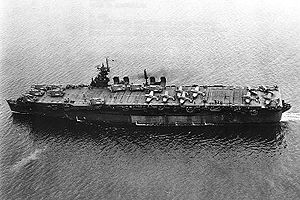 |
Training ships
During World War II, the United States Navy purchased two Great LakesGreat Lakes
The Great Lakes are a collection of freshwater lakes located in northeastern North America, on the Canada – United States border. Consisting of Lakes Superior, Michigan, Huron, Erie, and Ontario, they form the largest group of freshwater lakes on Earth by total surface, coming in second by volume...
side-wheel paddle steamer
Paddle steamer
A paddle steamer is a steamship or riverboat, powered by a steam engine, using paddle wheels to propel it through the water. In antiquity, Paddle wheelers followed the development of poles, oars and sails, where the first uses were wheelers driven by animals or humans...
s and converted them into freshwater aircraft carrier training ships. Both vessels were designated with the hull classification symbol IX and lacked hangar decks
Hangar
A hangar is a closed structure to hold aircraft or spacecraft in protective storage. Most hangars are built of metal, but other materials such as wood and concrete are also sometimes used...
, elevators or armament
Weapon
A weapon, arm, or armament is a tool or instrument used with the aim of causing damage or harm to living beings or artificial structures or systems...
s. The role of these ships was for the training of pilots for carrier take-offs and landings. Together the Sable and Wolverine trained 17,820 pilots in 116,000 carrier landings with 51,000 landings on Sable alone.
| Designation | Class | Ships | Active | Description | Lead Ship |
|---|---|---|---|---|---|
| IX-64 | Wolverine USS Wolverine (IX-64) USS Wolverine was a freshwater aircraft carrier of the United States Navy during World War II. She had been converted from a paddlewheeler coal-burning steamer to be used for advanced training for naval aviators in carrier take-offs and landings.... |
1 | 1942–1945 | Former Great Lakes paddle steamer Seeandbee converted for aircraft takeoff and landing training | |
| IX-81 | Sable USS Sable (IX-81) USS Sable was a training ship of the United States Navy during World War II. Originally built as the Greater Buffalo, a sidewheel excursion steamer, she was converted in 1942 to a freshwater aircraft carrier to be used on the Great Lakes. She was used for advanced training for naval aviators in... |
1 | 1943–1945 | Former Great Lakes paddle steamer Greater Buffalo converted for aircraft takeoff and landing training | |
Cold War
Aircraft carrier technology underwent many changes during the Cold WarCold War
The Cold War was the continuing state from roughly 1946 to 1991 of political conflict, military tension, proxy wars, and economic competition between the Communist World—primarily the Soviet Union and its satellite states and allies—and the powers of the Western world, primarily the United States...
. The first of the 45000 ton carriers, the was commissioned eight days after the end of World War II, on September 10. A larger ship was planned, and in 1948, President Harry Truman approved the construction of a "supercarrier
Supercarrier
Supercarrier is an unofficial descriptive term for the largest type of aircraft carrier, usually displacing over 70,000 long tons.Supercarrier is an unofficial descriptive term for the largest type of aircraft carrier, usually displacing over 70,000 long tons.Supercarrier is an unofficial...
", a 65000 ton aircraft carrier to be named ; however, the project was canceled in April 1949 by the Secretary of Defense. The Navy's first supercarriers came later, in 1955, with the Forrestal class
Forrestal class aircraft carrier
The Forrestal-class aircraft carriers were a four-ship class designed and built for the United States Navy in the 1950s. It was the first class of so-called supercarriers, combining high tonnage, deck-edge elevators and an angled deck...
. 1953 saw the first test of an angled-deck carrier, the .
The "N" suffix was added to the designation system to represent nuclear power
Nuclear power
Nuclear power is the use of sustained nuclear fission to generate heat and electricity. Nuclear power plants provide about 6% of the world's energy and 13–14% of the world's electricity, with the U.S., France, and Japan together accounting for about 50% of nuclear generated electricity...
ed carriers in 1956. The first carrier to receive this suffix was the , commissioned in 1961. The last carrier to be conventionally powered
Conventional warfare
Conventional warfare is a form of warfare conducted byusing conventional military weapons and battlefield tactics between two or more states in open confrontation. The forces on each side are well-defined, and fight using weapons that primarily target the opposing army...
, the , was commissioned in 1968, and was decommissioned in 2007.
The Korean War
Korean War
The Korean War was a conventional war between South Korea, supported by the United Nations, and North Korea, supported by the People's Republic of China , with military material aid from the Soviet Union...
began June 25, 1950, and the need for planes and troops was urgent. Returning from Korea, the made a record trip across the Pacific
Pacific Ocean
The Pacific Ocean is the largest of the Earth's oceanic divisions. It extends from the Arctic in the north to the Southern Ocean in the south, bounded by Asia and Australia in the west, and the Americas in the east.At 165.2 million square kilometres in area, this largest division of the World...
—7 days, 10 hours, and 36 minutes. In 1952, all carriers with designations "CV" or "CVB" were reclassified as attack carriers and given the sign "CVA".
As the Mercury-Redstone 3
Mercury-Redstone 3
Mercury-Redstone 3 was the first manned space mission of the United States. Astronaut Alan Shepard piloted a 15-minute Project Mercury suborbital flight in the Freedom 7 spacecraft on May 5, 1961 to become the first American in space, three weeks after the Soviet cosmonaut Yuri Gagarin had carried...
mission ended, the recovered Commander
Commander
Commander is a naval rank which is also sometimes used as a military title depending on the individual customs of a given military service. Commander is also used as a rank or title in some organizations outside of the armed forces, particularly in police and law enforcement.-Commander as a naval...
Alan B. Shepard, the first American in space, on May 5, 1961. Another aircraft carrier, the , recovered the Apollo 11
Apollo 11
In early 1969, Bill Anders accepted a job with the National Space Council effective in August 1969 and announced his retirement as an astronaut. At that point Ken Mattingly was moved from the support crew into parallel training with Anders as backup Command Module Pilot in case Apollo 11 was...
astronauts after their splashdown
Splashdown (spacecraft landing)
Splashdown is the method of landing a spacecraft by parachute in a body of water. It was used by American manned spacecraft prior to the Space Shuttle program. It is also possible for the Russian Soyuz spacecraft and Chinese Shenzhou spacecraft to land in water, though this is only a contingency...
. Apollo 11 was the first manned landing on the moon, and was composed of astronauts Neil Armstrong
Neil Armstrong
Neil Alden Armstrong is an American former astronaut, test pilot, aerospace engineer, university professor, United States Naval Aviator, and the first person to set foot upon the Moon....
, Buzz Aldrin
Buzz Aldrin
Buzz Aldrin is an American mechanical engineer, retired United States Air Force pilot and astronaut who was the Lunar Module pilot on Apollo 11, the first manned lunar landing in history...
, and Michael Collins
Michael Collins (astronaut)
Michael Collins is a former American astronaut and test pilot. Selected as part of the third group of fourteen astronauts in 1963, he flew in space twice. His first spaceflight was Gemini 10, in which he and command pilot John Young performed two rendezvous with different spacecraft and Collins...
.
In 1975, the first Nimitz class
Nimitz class aircraft carrier
The Nimitz-class supercarriers are a class of ten nuclear-powered aircraft carriers in service with the United States Navy. With an overall length of and full-load displacements of over 100,000 long tons, they are the largest capital ships in the world...
aircraft carrier was commissioned; the Nimitz class are the largest warships in the world; and is the only aircraft carrier class in commission with the U.S. Navy, except for the . Construction and commissioning of the Nimitz class continued after the Cold War.
Also, in 1975, the U.S. Navy simplified the carrier designations—CV, CVA, CVAN, CVB, CVL—into CV for conventionally powered carriers and CVN for nuclear-powered carriers.
| Designation | Class | Ships | Active | Description | Lead Ship |
|---|---|---|---|---|---|
| CV-41 | Midway Midway class aircraft carrier The Midway class aircraft carrier was one of the longest lived carrier designs in history. First commissioned in late 1945, the lead ship of the class, was not decommissioned until 1992, shortly after service in Operation Desert Storm in 1991.-History:... |
1945 – 1992 | This class was one of the longest lived carrier designs in history. First commissioned in late 1945, the lead ship of the class, was not decommissioned until 1992, shortly after seeing service in the Gulf War Gulf War The Persian Gulf War , commonly referred to as simply the Gulf War, was a war waged by a U.N.-authorized coalition force from 34 nations led by the United States, against Iraq in response to Iraq's invasion and annexation of Kuwait.The war is also known under other names, such as the First Gulf... . Six were planned; 3 were built including the Coral Sea USS Coral Sea (CV-43) USS Coral Sea , a , was the third ship of the United States Navy to be named for the Battle of the Coral Sea. She earned the affectionate nickname "Ageless Warrior" through her long career... (CV-43) and Franklin D. Roosevelt USS Franklin D. Roosevelt (CV-42) USS Franklin D. Roosevelt was the second of three Midway class aircraft carriers. To her crew, she was known as the "Swanky Franky," "Foo-De-Roo," or "Rosie," with the last nickname probably the most popular. Roosevelt spent most of her active deployed career operating in the Mediterranean Sea as... (CV-42). The class was originally designated CVB. |
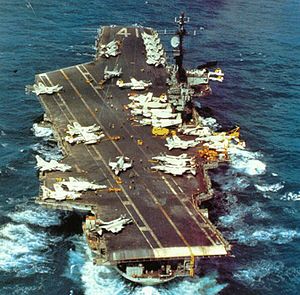 |
|
| CVL-48 | Saipan Saipan class aircraft carrier The Saipan class aircraft carriers were a class of two light carriers [ and ] built for the United States Navy during World War II. Like the nine Independence- class light carriers, they were based on cruiser hulls... |
1946 – 1970 | Built on modified Baltimore class cruiser Baltimore class cruiser The Baltimore class cruiser was a type of heavy cruiser in the United States Navy from the last years of the Second World War. Fast and heavily armed, ships like the Baltimore cruisers were mainly used by the Navy in World War II to protect the fast aircraft carriers in carrier battle groups... hulls. Both were converted to command-and-control ships in the mid-1950s: to Arlington, to CC-2. |
 |
|
| CVA-58 | None commissioned | This class was never commissioned (3 more were planned). See Revolt of the Admirals Revolt of the Admirals The Revolt of the Admirals is a name given to an episode that took place in the late 1940s in which several United States Navy admirals and high-ranking civilian officials publicly disagreed with the President and the Secretary of Defense's strategy and plans for the military forces in the early... for details. |
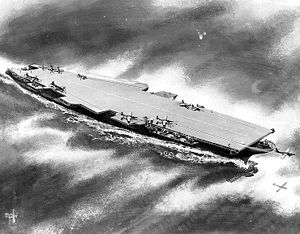 |
||
| CV-59 | Forrestal Forrestal class aircraft carrier The Forrestal-class aircraft carriers were a four-ship class designed and built for the United States Navy in the 1950s. It was the first class of so-called supercarriers, combining high tonnage, deck-edge elevators and an angled deck... |
1955 – 1998 | The Forrestal class was the first class of "supercarrier Supercarrier Supercarrier is an unofficial descriptive term for the largest type of aircraft carrier, usually displacing over 70,000 long tons.Supercarrier is an unofficial descriptive term for the largest type of aircraft carrier, usually displacing over 70,000 long tons.Supercarrier is an unofficial... s" of the Navy, so called because of their then-extraordinarily high tonnage (75,000 tons, 25% larger than the Midway class Midway class aircraft carrier The Midway class aircraft carrier was one of the longest lived carrier designs in history. First commissioned in late 1945, the lead ship of the class, was not decommissioned until 1992, shortly after service in Operation Desert Storm in 1991.-History:... ), and full integration of the angled deck. |
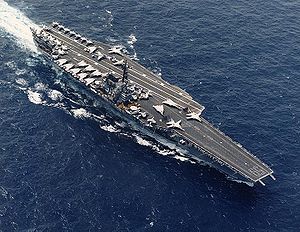 |
|
| CV-63 | Kitty Hawk Kitty Hawk class aircraft carrier The Kitty Hawk-class supercarriers of the United States Navy were an incremental improvement on the Forrestal-class vessels. Four were built, all in the 1960s, , , and... |
1961 – 2009 | Sometimes called "Improved Forrestal class". Sometimes mistaken as a four-ship class, with (see below) as a member. The biggest differences from the Forrestals are greater length, and a different placement of elevator Elevator An elevator is a type of vertical transport equipment that efficiently moves people or goods between floors of a building, vessel or other structures... s; two are forward of the island, with a third at the portside stern. |
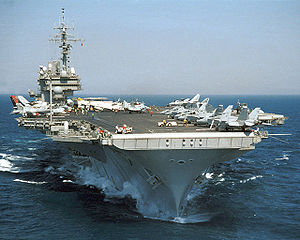 |
|
| CVN-65 | 1961 – Present | First nuclear-powered aircraft carrier, using eight A2W reactor A2W reactor The A2W reactor is a naval reactor used by the United States Navy to provide electricity generation and propulsion on warships. The A2W designation stands for:* A = Aircraft carrier platform* 2 = Second generation core designed by the contractor... s. Enlarged, modified, and nuclear-powered Kitty Hawk-class design. As of 2011 Enterprise is the oldest ship in the US Navy after the sail frigate Constitution, and has been in active operational service for 50 years, longer than any combatant ship in American history. |
 |
||
| CV-67 | 1968 – 2007 | Last conventionally powered Conventional warfare Conventional warfare is a form of warfare conducted byusing conventional military weapons and battlefield tactics between two or more states in open confrontation. The forces on each side are well-defined, and fight using weapons that primarily target the opposing army... aircraft carrier built (as of 2009). Sometimes grouped as a Kitty Hawk class ship. Laid down as a nuclear ship to use four A3W reactor A3W reactor The A3W reactor is a naval reactor used by the United States Navy to provide electricity generation and propulsion on warships. The A3W designation stands for:* A = Aircraft carrier platform* 3 = Third generation core designed by the contractor... s, converted to conventional propulsion early in construction. |
 |
||
| CVN-68 | Nimitz Nimitz class aircraft carrier The Nimitz-class supercarriers are a class of ten nuclear-powered aircraft carriers in service with the United States Navy. With an overall length of and full-load displacements of over 100,000 long tons, they are the largest capital ships in the world... |
1975 – Present | A line of nuclear-powered supercarriers in service with the US Navy using two A4W reactor A4W reactor The A4W reactor is a naval reactor used by the United States Navy to propel warships and generate onboard electricity.The A4W designation stands for:* A = Aircraft carrier platform* 4 = Fourth-generation core designed by the contractor... s, and the largest capital ships in the world. The Nimitz class are numbered with consecutive hull numbers starting with CVN 68. Ten ships are in the class . |
 |
After the Cold War
When the Cold WarCold War
The Cold War was the continuing state from roughly 1946 to 1991 of political conflict, military tension, proxy wars, and economic competition between the Communist World—primarily the Soviet Union and its satellite states and allies—and the powers of the Western world, primarily the United States...
ended in 1991, the U.S. Navy
United States Navy
The United States Navy is the naval warfare service branch of the United States Armed Forces and one of the seven uniformed services of the United States. The U.S. Navy is the largest in the world; its battle fleet tonnage is greater than that of the next 13 largest navies combined. The U.S...
had conventionally powered
Conventional warfare
Conventional warfare is a form of warfare conducted byusing conventional military weapons and battlefield tactics between two or more states in open confrontation. The forces on each side are well-defined, and fight using weapons that primarily target the opposing army...
carriers from the classes Midway
Midway class aircraft carrier
The Midway class aircraft carrier was one of the longest lived carrier designs in history. First commissioned in late 1945, the lead ship of the class, was not decommissioned until 1992, shortly after service in Operation Desert Storm in 1991.-History:...
, Forrestal
Forrestal class aircraft carrier
The Forrestal-class aircraft carriers were a four-ship class designed and built for the United States Navy in the 1950s. It was the first class of so-called supercarriers, combining high tonnage, deck-edge elevators and an angled deck...
, and Kitty Hawk
Kitty Hawk class aircraft carrier
The Kitty Hawk-class supercarriers of the United States Navy were an incremental improvement on the Forrestal-class vessels. Four were built, all in the 1960s, , , and...
active, along with the ; and the nuclear
Nuclear power
Nuclear power is the use of sustained nuclear fission to generate heat and electricity. Nuclear power plants provide about 6% of the world's energy and 13–14% of the world's electricity, with the U.S., France, and Japan together accounting for about 50% of nuclear generated electricity...
carriers Nimitz
Nimitz class aircraft carrier
The Nimitz-class supercarriers are a class of ten nuclear-powered aircraft carriers in service with the United States Navy. With an overall length of and full-load displacements of over 100,000 long tons, they are the largest capital ships in the world...
class and the ; however, all of the conventional carriers have been decommissioned. Construction of the Nimitz class continued after the Cold War, and the last Nimitz class carrier was commissioned in 2009.
The next class of supercarriers—the Gerald R. Ford class—is planned to launch the first ship in 2015. The new carriers will be stealthier, and feature A1B reactor
A1B reactor
The A1B reactor is a nuclear reactor being designed for use by the United States Navy to provide electricity generation and propulsion for the Gerald R. Ford-class aircraft carriers...
s, electromagnetic catapults
Aircraft catapult
An aircraft catapult is a device used to launch aircraft from ships—in particular aircraft carriers—as a form of assisted take off. It consists of a track built into the flight deck, below which is a large piston or shuttle that is attached through the track to the nose gear of the aircraft, or in...
, advanced arresting gear, reduced crew requirements, and a hull design based upon that of the Nimitz class. Ten carriers are planned for the Gerald R. Ford class.
| Designation | Class | Ships | Active | Description | Lead Ship |
|---|---|---|---|---|---|
| CVN-78 | Gerald R. Ford | (2015 planned) | The next generation supercarrier for the United States Navy. Carriers of the Ford class will incorporate many new design features including a new nuclear reactor design A1B reactor The A1B reactor is a nuclear reactor being designed for use by the United States Navy to provide electricity generation and propulsion for the Gerald R. Ford-class aircraft carriers... , stealthier features to help reduce radar profile, electromagnetic catapults Aircraft catapult An aircraft catapult is a device used to launch aircraft from ships—in particular aircraft carriers—as a form of assisted take off. It consists of a track built into the flight deck, below which is a large piston or shuttle that is attached through the track to the nose gear of the aircraft, or in... , advanced arresting gear, and reduced crewing requirements. The Ford class uses the basic hull design of the preceding Nimitz-class. Ten ships are currently planned for the Gerald R. Ford class. |
 |
Escort Carriers
During World War IIWorld War II
World War II, or the Second World War , was a global conflict lasting from 1939 to 1945, involving most of the world's nations—including all of the great powers—eventually forming two opposing military alliances: the Allies and the Axis...
, the U.S. Navy
United States Navy
The United States Navy is the naval warfare service branch of the United States Armed Forces and one of the seven uniformed services of the United States. The U.S. Navy is the largest in the world; its battle fleet tonnage is greater than that of the next 13 largest navies combined. The U.S...
built escort carriers in large numbers for patrol work, and scouting and escorting convoy
Convoy
A convoy is a group of vehicles, typically motor vehicles or ships, traveling together for mutual support and protection. Often, a convoy is organized with armed defensive support, though it may also be used in a non-military sense, for example when driving through remote areas.-Age of Sail:Naval...
s. Escort carriers were smaller than aircraft carrier
Aircraft carrier
An aircraft carrier is a warship designed with a primary mission of deploying and recovering aircraft, acting as a seagoing airbase. Aircraft carriers thus allow a naval force to project air power worldwide without having to depend on local bases for staging aircraft operations...
s; escort carrier crews referred to the ships as "Jeep carriers", the press called them "baby flat tops". The escort carriers had lighter armor than aircraft carriers, were slower, had less defensive armament, and fewer aircraft. This smaller variant of carriers was designated "CVE"; a common joke amongst crews was "CVE" meant "Combustible, Vulnerable and Expendable".
Early in the war, German
Nazi Germany
Nazi Germany , also known as the Third Reich , but officially called German Reich from 1933 to 1943 and Greater German Reich from 26 June 1943 onward, is the name commonly used to refer to the state of Germany from 1933 to 1945, when it was a totalitarian dictatorship ruled by...
submarine
Submarine
A submarine is a watercraft capable of independent operation below the surface of the water. It differs from a submersible, which has more limited underwater capability...
s and aircraft were interfering with shipping. The worst losses occurred far at sea—out of the reach of land-based air forces—leading the Royal Navy
Royal Navy
The Royal Navy is the naval warfare service branch of the British Armed Forces. Founded in the 16th century, it is the oldest service branch and is known as the Senior Service...
to experiment with catapult-launching fighter aircraft
Fighter aircraft
A fighter aircraft is a military aircraft designed primarily for air-to-air combat with other aircraft, as opposed to a bomber, which is designed primarily to attack ground targets...
from merchant ships, a somewhat successful approach. However, the number of planes was still limited, so the United Kingdom
United Kingdom
The United Kingdom of Great Britain and Northern IrelandIn the United Kingdom and Dependencies, other languages have been officially recognised as legitimate autochthonous languages under the European Charter for Regional or Minority Languages...
appealed to the United States
United States
The United States of America is a federal constitutional republic comprising fifty states and a federal district...
for help.
Before World War II started, the U.S. Navy had contemplated converting merchant ships to small aircraft carriers for this purpose, so the quick solution was to build escort carriers on merchant ship hulls. The first escort carrier, the , was converted from a freighter. A shortage of merchant ship hulls caused four escort carriers—, , , and —to be built on oil tanker
Oil tanker
An oil tanker, also known as a petroleum tanker, is a merchant ship designed for the bulk transport of oil. There are two basic types of oil tankers: the crude tanker and the product tanker. Crude tankers move large quantities of unrefined crude oil from its point of extraction to refineries...
hulls. In total, 78 escort carriers were built and launched from June 1941 to April 1945.
| Designation | Class | Ships | Description | Lead Ship |
|---|---|---|---|---|
| CVE-1 | Long Island Long Island class escort carrier The Long Island-class escort carrier was a two-ship class, originally listed as "AVG" . They were converted from merchant ships.... |
2 | 1 in USN service (USS Long Island), and . | 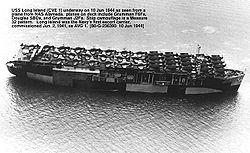 |
| CVE-9 | Bogue Bogue class escort carrier The Bogue-class were a group of escort carriers built in the United States for service with the U.S. Navy and the Royal Navy during World War II.... |
45 | 11 in Royal Navy Royal Navy The Royal Navy is the naval warfare service branch of the British Armed Forces. Founded in the 16th century, it is the oldest service branch and is known as the Senior Service... service, rest in U.S. Navy United States Navy The United States Navy is the naval warfare service branch of the United States Armed Forces and one of the seven uniformed services of the United States. The U.S. Navy is the largest in the world; its battle fleet tonnage is greater than that of the next 13 largest navies combined. The U.S... . British service as HMS Attacker HMS Attacker (D02) HMS Attacker was an American-built Attacker-class escort aircraft carrier that served with the Royal Navy during the Second World War.... class (first batch) and HMS Ameer class (second batch). |
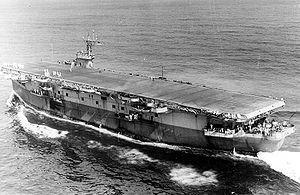 |
| CVE-26 | Sangamon Sangamon class escort carrier The Sangamon class were a group of four escort aircraft carriers of the United States Navy that served during World War II.-Overview:These ships were originally MARAD type T3-S2-A1 oilers, launched in 1939 for civilian use. They were acquired and commissioned by the U.S. Navy in 1940-41... |
4 | All in USN service. Built on oil tanker hulls rather than merchant ship hulls. | 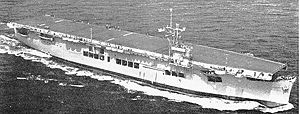 |
| CVE-30 | Charger | 4 | 1 mainly in USN service, 3 in British service as Avenger Avenger class escort carrier There were three Avenger class escort carriers in service with the Royal Navy during the Second World War. All three were originally American merchant ships in the process of being built at the Sun Shipbuilding and Drydock Company Chester, Pennsylvania... class. |
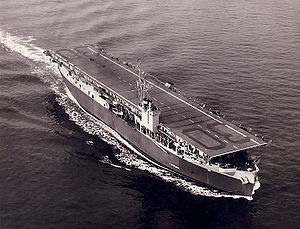 |
| CVE-55 | Casablanca Casablanca class escort carrier The Casablanca class escort aircraft carriers were the greatest number of not only escort carriers, but also any size aircraft carrier ever built to a like-design by any nation at any time. Fifty were laid down, launched and commissioned within the space of less than two years - 3 November 1942... |
50 | All in USN service. | 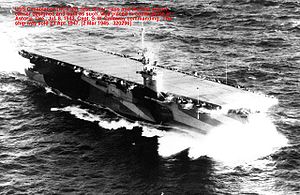 |
| CVE-105 | Commencement Bay Commencement Bay class escort carrier The Commencement Bay-class escort aircraft carriers were based on the Maritime Commission T3 type tanker hull, which gave them a displacement of approximately 23,000 tons and a length of 557 feet... |
19 | All in USN service. Includes two units which were accepted but not commissioned and laid up for many years after the war. |
See also
- List of aircraft carriers of the United States Navy
- List of escort aircraft carriers of the United States Navy

